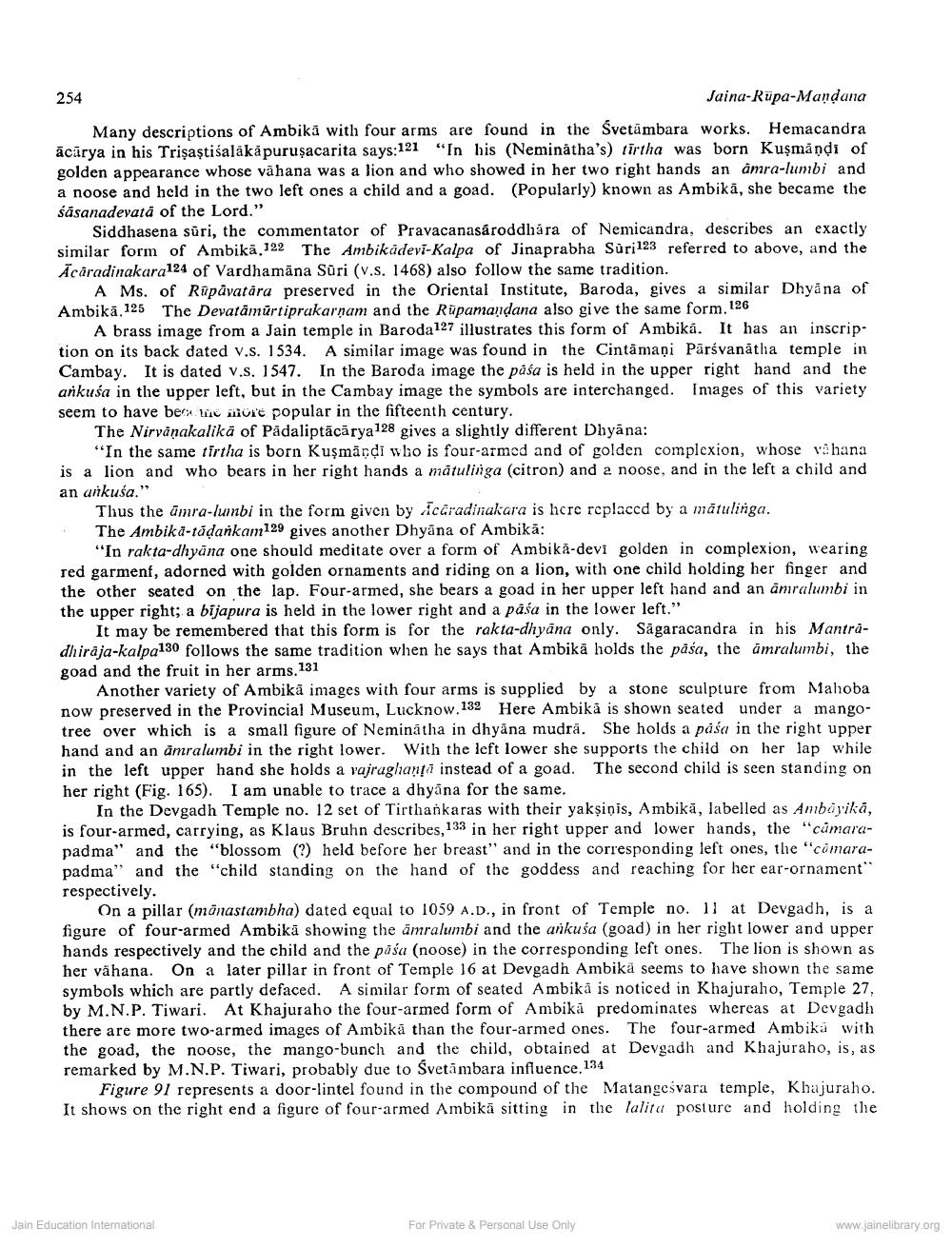________________
254
Jaina-Rupa-Mandana Many descriptions of Ambika with four arms are found in the Svetämbara works. Hemacandra ācārya in his Trişastišaläkāpuruşacarita says:121 "In his (Neminātha's) tirtha was born Kuşmandi of golden appearance whose vähana was a lion and who showed in her two right hands an amra-lumbi and a noose and held in the two left ones a child and a goad. (Popularly known as Ambikä, she became the śasanadevată of the Lord."
Siddhasena sūri, the commentator of Pravacanasároddhára of Nemicandra, describes an exactly similar form of Ambika, 122 The Ambikadevi-Kalpa of Jinaprabha Suri 123 referred to above, and the Acaradinakara124 of Vardhamana Suri (V.S. 1468) also follow the same tradition.
A Ms. of Rūpävatara preserved in the Oriental Institute, Baroda, gives a similar Dhyana of Ambikā.125 The Devatämürtiprakarnam and the Rūpamandana also give the same form. 126
A brass image from a Jain temple in Baroda 127 illustrates this form of Ambika. It has an inscription on its back dated v.s. 1534. A similar image was found in the Cintāmaņi Pārsvanātha temple in Cambay. It is dated v.s. 1547. In the Baroda image the paśa is held in the upper right hand and the arkusa in the upper left, but in the Cambay image the symbols are interchanged. Images of this variety seem to have bera
m ore popular in the fifteenth century. The Nirvånakalika of Padaliptācārya 128 gives a slightly different Dhyana:
"In the same tirtha is born Kuşmārdi who is four-armed and of golden complexion, whose và hana is a lion and who bears in her right hands a matulinga (citron) and a noose, and in the left a child and an arkusa."
Thus the ūmra-lumbi in the form given by caradinakara is here replaced by a matulinga. The Ambika-tadankam129 gives another Dhyana of Ambikā:
"In rakta-dhyāna one should meditate over a form of Ambika-devi golden in complexion, wearing red garmenf, adorned with golden ornaments and riding on a lion, with one child holding her finger and the other seated on the lap. Four-armed, she bears a goad in her upper left hand and an aniralumbi in the upper right; a bijapura is held in the lower right and a påsa in the lower left."
It may be remembered that this form is for the rakta-dhyāna only. Sagaracandra in his Mantradhiraja-kalpa 130 follows the same tradition when he says that Ambikā holds the påsa, the amralumnbi, the goad and the fruit in her arms.131
Another variety of Ambikā images with four arms is supplied by a stone sculpture from Mahoba now preserved in the Provincial Museum, Lucknow. 132 Here Ambika is shown seated under a mangotree over which is a small figure of Neminātha in dhyāna mudrā. She holds a paša in the right upper hand and an amralumbi in the right lower. With the left lower she supports the child on her lap while in the left upper hand she holds a vajraghantā instead of a goad. The second child is seen standing on her right (Fig. 165). I am unable to trace a dhyana for the same.
In the Devgadh Temple no. 12 set of Tirthankaras with their yaksinis, Ambikā, labelled as Ambavika, is four-armed, carrying, as Klaus Bruhn describes, 133 in her right upper and lower hands, the "cámarapadma" and the "blossom (?) held before her breast" and in the corresponding left ones, the "comarapadma" and the "child standing on the hand of the goddess and reaching for her ear-ornament" respectively.
On a pillar (mõnastambha) dated equal to 1059 A.D., in front of Temple no. 11 at Devgadh, is a figure of four-armed Ambikā showing the amralumbi and the ankuša (goad) in her right lower and upper hands respectively and the child and the pāśa (noose) in the corresponding left ones. The lion is shown as her vähana. On a later pillar in front of Temple 16 at Devgadh Ambika seems to have shown the same symbols which are partly defaced. A similar form of seated Ambikā is noticed in Khajuraho, Temple 27, by M.N.P. Tiwari. At Khajuraho the four-armed form of Ambika predominates whereas at Devgadh there are more two-armed images of Ambika than the four-armed ones. The four-armed Ambika with the goad, the noose, the mango-bunch and the child, obtained at Devgadh and Khajuraho, is, as remarked by M.N.P. Tiwari, probably due to Svetambara influence 134
Figure 91 represents a door-lintel found in the compound of the Matangeśvara temple, Khajuraho. It shows on the right end a figure of four-armed Ambikā sitting in the lalitu posture and holding the
Jain Education International
For Private & Personal Use Only
www.jainelibrary.org




